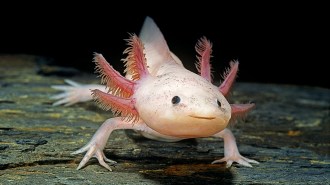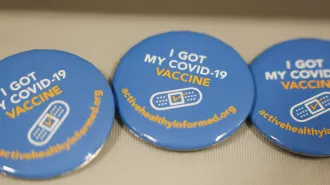This is the teenager’s brain on peer pressure
Highlights from day four of the Society for Neuroscience annual meeting
WASHINGTON — Tuesday, November 18, 2008, was the fourth day of the Society for Neuroscience annual meeting, and topics remained diverse: What happens in the brain when teenagers feel peer pressure, a study in mice suggesting a new way to treat depression, the best way to relearn walking after a stroke, and the long lasting effects of disrupted sleep.
Peer pressure on the brain All too often, teenagers act recklessly and even dangerously around their friends. A new study suggests that this rash behavior feeds off the teen brain’s sensitivity to social and emotional influences, which is substantially unbridled because a cognitive and behavioral control network is not yet mature. The brain’s control network doesn’t coalesce until the early 20s, a change that enables the network to communicate better with neural pathways that handle social and emotional responses, propose Jason Chein of Temple University in Philadelphia and his colleagues. As a result, hazardous behavior around friends declines, they say. The researchers studied nine teenagers, ages 15 to 19, and eight young adults, ages 20 to 28. Each volunteer completed two tasks while reclining in an functional MRI machine. On some trials, participants were alone; during others, two of their same-sex friends watched the proceedings. One task involved using a driving simulator to direct a virtual car as quickly as possible down a straight road, trying to avoid getting in crashes at intersections. The other task required participants to blow up balloons for cash rewards. Big balloons yielded more money than small ones did, but popped balloons were worthless. Teens, but not adults, got in more car crashes and popped more balloons when they had an audience. In those trials, the teens’ brains displayed enhanced activity in predominantly right brain areas that handle social and emotional information. With friends watching, young adults’ brains showed especially pronounced activity in mainly left brain areas that have been implicated in controlling thoughts and actions. — Bruce Bower
Study finds possible new target for treating depression Changing DNA’s shape in cells in a certain part of the brain can rescue mice from depression, a new study shows. What had brought on depression in the mice was a daily diet of defeat. Allowing a large male mouse to “beat up” a smaller mouse for five minutes daily caused chronic stress in the pummeled mice, says author Herbert Covington of Mount Sinai School of Medicine in New York City. Not surprisingly, mice subjected to this brutal regimen for 10 days became depressed. The mouse victims showed abnormal social interactions and poor performance on physical tests like swimming. “It works very well,” says Covington. Recent experiments from the field of epigenetics, which is concerned with the structure of DNA, have linked the shape of DNA in the brain to depression in animals. Scientists knew that loosely packaged DNA is more active and produces more proteins than tightly wound DNA. But no one knew the regions of the brain where DNA shape mattered for depression. The researchers targeted each of four regions of the depressed mouse brain with a histone deacetylase inhibitor, a chemical that can modify DNA shape. The goal was to determine where changing the DNA shape brought about the most relief. The depressed mice drastically improved when treatment targeted the nucleus accumbens, a part of the brain that in mice plays an important role in depression. What’s more, the improvements in behavior rivaled those seen in mice given common anti-depression drugs like imipramine or fluoxetine. To uncover more details about this part of the brain and how it may relate to depression, the researchers next hope to study individual genes that change in the nucleus accumbens as a result of depression. — Laura Sanders
Remembering and forgetting — and walking When out on a stroll, most people focus on the flowers or their surroundings, not their legs. But people recovering from a stroke often try to consciously control their movements in an effort to regain their normal gait. Now scientists propose a different tact for these folks: don’t think about it. A study at Johns Hopkins University shows that focusing on something other than walking may help patients in the long run. Researchers studied three groups of healthy volunteers on a treadmill to see how distraction affects learning and retention when learning a new walking pattern. A split-belt treadmill was set so that one leg moved three times faster than the other leg. The first group adapted to the new pace without instruction. A second group received visual and verbal feedback about their stepping patterns, while the third group was distracted during the training process and asked to watch a sitcom and then answer questions about the program. People in all three groups adapted to the new pace within 15 minutes, although the distracted walkers were slower to pick up the pace. When subjects were then instructed to return to normal walking patterns, the distracted walkers again lagged behind the others in adapting to the change, despite removal of the distraction. “By distracting subjects during training, we may be drawing on more subconscious areas of the brain,” says Laura Malone, a doctoral student who worked with Amy Bastian on the study. “While these brain centers are slower to learn new information, they are also slower to forget.” The scientists now plan to take the study a step further and test the approach on patients recovering from strokes. — Susan Gaidos
Weeks later, sluggishness from disrupted sleep remains Sleep that is constantly disrupted — such as that experienced by new parents, the elderly and those with sleep apnea — can cause sluggish thinking weeks after sleep habits return to normal, suggests new research in rats. Scientists knew that the rat dentate gyrus, an area of the brain’s hippocampus involved with memories, has difficulty growing new nerve cells when the rodents get only fragmented sleep. To investigate the longer term effect of fractured sleep on learning, researchers connected electrodes to the brains of 11 rats whose cage bottoms were treadmills. Whenever a computer detected that a rat had been sleeping for 30 seconds, the treadmill turned on, waking the animal. The rats experienced this disrupted sleep for 12 days and then were allowed to sleep as much as they wanted for two weeks. Led by Dennis McGinty, chief of neurophysiology research at the Sepulveda Veterans Affairs Medical Center in California, the researchers then gave the rats some tasks. In five trials over five days the rats had to pick out an escape hole from 22 holes on the perimeter of a large platform. On the sixth day, the position of the hole changed. Control rats, whose sleep had not been disrupted, began by randomly checking holes, then sequentially checking them, and then going right to the hole. But the sleep-deprived rats had trouble finding the escape hatch and took longer to find the new route when the location changed. McGinty likens the sleep-deprived rats to elderly people who no longer remember where their car is parked in a big garage. “Something about the continuity [of sleep] is crucial,” he says. —Rachel Ehrenberg







